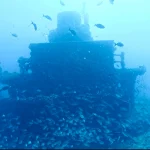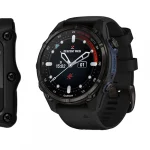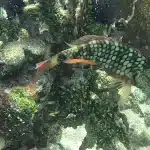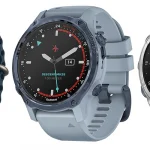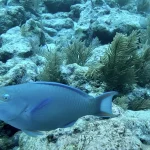Table of Contents
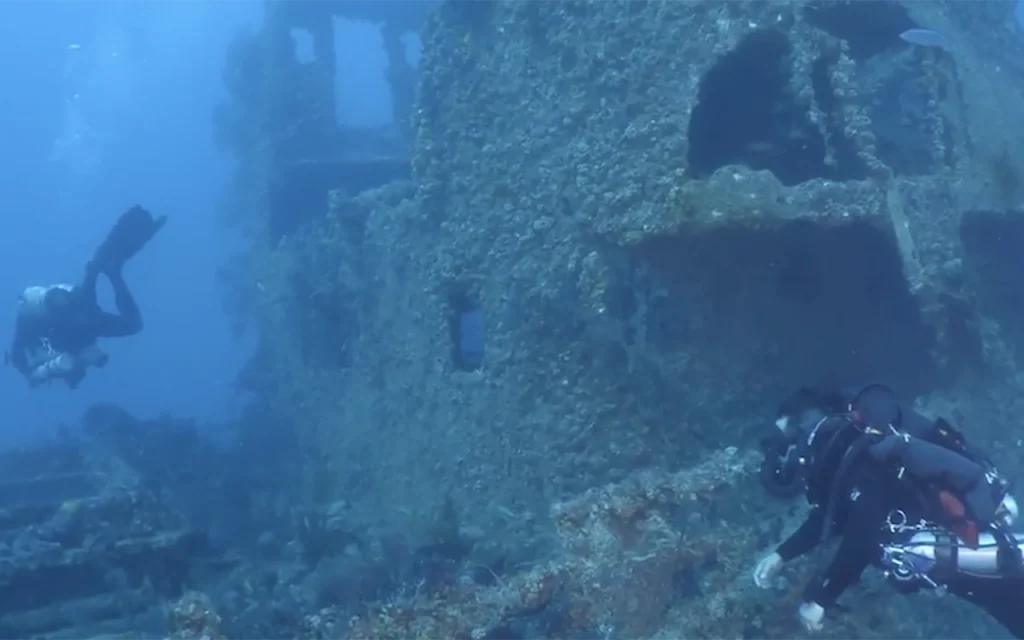
The combination of its intact structure, rich marine life, challenging depth, and interesting history makes the Miller Lite wreck a unique and rewarding dive site for advanced scuba divers.
Article at a Glance
- Historical Background: The Miller Lite wreck, originally launched as the Mimi Horn in 1957, served various roles before being intentionally sunk as an artificial reef off Pompano Beach, Florida, in 1987.
- Diving Depth: The wreck lies at a depth of approximately 160 feet, with its deck situated around 140-145 feet, making it suitable for advanced divers.
- Structural Integrity: The ship remains largely intact, featuring an upright position with its mast still standing, providing divers with a striking visual element.
- Marine Ecosystem: The wreck has transformed into a vibrant artificial reef, hosting diverse marine life, including large schools of fish, barracudas, and various coral species like sea fans and buttercup corals.
- Diving Conditions: Visibility can reach up to 100 feet on good days, with typical currents around 1 knot, making for enjoyable diving experiences.
- Safety Measures: Due to its depth, divers are advised to have advanced certifications and follow safety protocols, including pre-dive planning and the buddy system.
- Diving Services: Several local dive shops in Pompano Beach offer guided trips to the Miller Lite wreck, providing divers with opportunities to explore this unique underwater site.
Shipwreck Location Coordinates and Depth
Depth
- Depth: The wreck sits in about 160 feet of water
- Deck depth: Approximately 140-145 feet
Location Coordinates
Coordinates: 26° 12.394′ N, 80° 02.749′ W
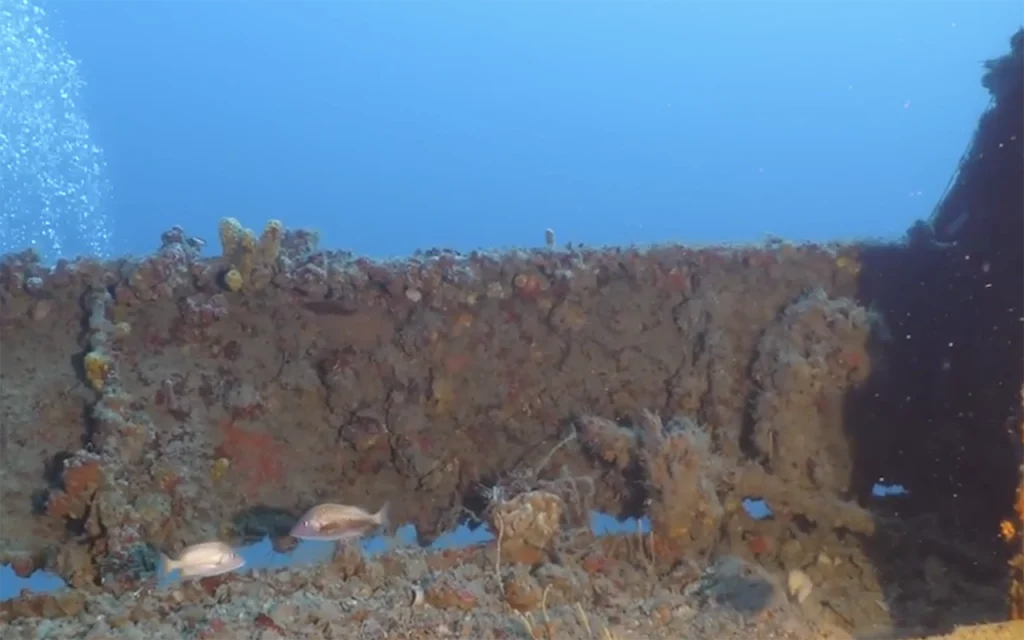
What Do Scuba Divers Say About This Ship
Dive Experience
- The wreck is described as being in good shape, with much of its original structure still intact.
- Divers report that the mast is still erect, often with a solitary barracuda swimming around its top.
- The wreck has lots of profile and structure to explore, making it worthy of a dedicated dive.
Marine Life
- The Miller Lite is teeming with fish, likely due to its proximity to Hillsboro Inlet.
- Divers often encounter large schools of fish covering the wreckage.
- Sea fans and buttercup corals cover much of the wreck, creating an artificial reef environment.
Diving Conditions
- Visibility can be excellent, with reports of up to 100 feet on good days.
- The current is typically around 1 knot1.
- Water temperature is reported to be about 76 degrees Fahrenheit from top to bottom.
Dive Profile
- The wreck sits in about 160 feet of water, with the deck at approximately 140-145 feet.
- Due to its depth, it’s recommended for advanced divers.
- Some divers report staying on the deck at around 140 feet during their exploration.
Cautions
While some parts of the wreck are accessible at recreational diving limits, more advanced training is recommended for a full exploration.
Divers are warned to watch out for monofilament fishing line on the wreck.
What Kind of Marine Life Can Be Found on The Ship
Fish Species
- Large schools of fish often cover the wreckage
- Solitary barracuda are frequently seen swimming around the top of the mast
- Various reef fish species inhabit the structure
Coral and Invertebrates
- Sea fans cover much of the wreck
- Buttercup corals are prevalent throughout the structure
- The wreck serves as an artificial reef, promoting coral growth
Other Marine Life
- The wreck’s proximity to Hillsboro Inlet contributes to its abundance of marine life
- Divers report seeing a diverse ecosystem thriving on and around the ship
Seasonal Variations
While not specifically mentioned for the Miller Lite, nearby wrecks in the area are known to attract:
- Sharks during summer months
- Seasonal fish like cod and sea bass at certain times of the year
Key Information
| Attribute | Details |
|---|---|
| Original Name | Mimi Horn |
| Launch Date | September 28, 1957 |
| Launch Location | Travemünde, Germany |
| Builder | Schlichting Werft |
| Original Purpose | Refrigerated cargo ship |
| Length | 206 feet (62.8 meters) |
| Tonnage | 741 tons |
| Sinking Date | May 17, 1987 |
| Sinking Purpose | Artificial reef |
| Current Location | Off Pompano Beach, Florida |
| Coordinates | 26° 12.394′ N, 80° 02.749′ W |
| Depth | 160-165 feet (48.8-50.3 meters) |
| Deck Depth | Approximately 140-145 feet (42.7-44.2 meters) |
| Orientation | Upright, bow pointing southeast |
| Condition | Mostly intact, front bulkheads of wheelhouse collapsed |
| Notable Features | Erect mast, large navigable engine room |
| Marine Life | Covered in gorgonian growth, large schools of fish |
| Recommended for | Advanced divers |
What Makes The Miller Lite Shipwreck a Unique Diving Experience
Location and Depth
- Situated close to Hillsboro Inlet, contributing to abundant marine life
- Rests in about 160 feet of water, with the deck at approximately 140-145 feet24
- Provides an advanced diving challenge due to its depth
Structural Integrit
- The ship is still fairly intact, preserving much of its original structure
- The mast remains erect, offering a striking visual element
- Boasts significant profile and structure to explore
Marine Life
- Teeming with fish, often covered by large schools
- Rich coral growth, including sea fans and buttercup corals
- Frequently hosts a solitary barracuda near the mast’s top
Diving Conditions
- Excellent visibility, reported up to 100 feet on good days
- Typically experiences about 1 knot of current
- Water temperature around 76 degrees Fahrenheit from top to bottom
Historical Significance
- Originally launched in 1957 as the Mimi Horn in Germany
- Served various purposes and had multiple name changes before becoming an artificial reef
- Sunk intentionally on May 17, 1987, as part of an artificial reef program
How Does The Miller Lite Compare to Other Shipwrecks in Florida
Historical Significance
- Many Florida shipwrecks, like those from the 1733 Spanish fleet, have significant historical value dating back to colonial times1.
- The Miller Lite, sunk in 1987, is a more modern artificial reef and lacks the historical importance of older wrecks.
Depth and Accessibility
- The Miller Lite rests at about 160 feet deep, with its deck at 140-145 feet.
- This is deeper than many popular dive sites in Florida, such as those in the Keys, which are often in shallower waters accessible to recreational divers.
Preservation and Structure
- Older shipwrecks like the Emanuel Point Wreck (1559) or the Atocha (1622) often have only partial remains preserved.
- The Miller Lite, being relatively recent, is still largely intact with much of its original structure preserved.
Marine Life
- Like many Florida wrecks, the Miller Lite serves as an artificial reef, hosting a variety of marine life.
- However, older wrecks may have more established ecosystems due to being underwater for longer periods.
Diving Experience
- The Miller Lite offers a technical diving experience due to its depth, similar to some other advanced dive sites in Florida.
- It lacks the treasure-hunting allure of historic wrecks like the Atocha, which yielded significant artifacts.
Location
- Many famous Florida wrecks are located in the Keys or off the Atlantic coast.
- The Miller Lite, off Pompano Beach, is in a less historically prominent area for shipwrecks.
What is The Full History of This Ship
Origins and Early Years
- Launched on September 28, 1957, in Travemünde, Germany
- Built by Schlichting Werft shipyard
- Originally named Mimi Horn
- Commissioned for Heinrich C. Horn of Hamburg, Germany
- Specifications: 741-ton refrigerated cargo ship, 172 feet long, 28 feet wide
Early Operations
- Initially operated transporting frozen fish from Spanish fishing trawlers
- Acquired by Hamburg South American Line in 1965
Changes in Ownership and Names
- 1968: Sold to a Panamanian company and renamed Shirley B
- 1970: Operated under two names – Aquarius and Hybur Transport
- 1983: Renamed Principe Maya
Final Years and Artificial Reef Project
- 1987: Purchased for $30,000 by Broward County and the Pompano Beach Fishing Rodeo
- Renamed Miller Lite in tribute to Fishing Rodeo sponsors Miller Brewing Co. and local distributor William Thies and Sons
- Prepared for sinking as an artificial reef
- May 17, 1987: Intentionally scuttled off the coast of Pompano Beach, Florida
Current State
- Sits upright in 165 feet of water
- Deck is at approximately 145 feet depth
- Mostly intact, with some deterioration (front bulkheads of wheelhouse have collapsed)
- Engine room is large and easily navigable
- Now covered in gorgonian growth, serving as an artificial reef
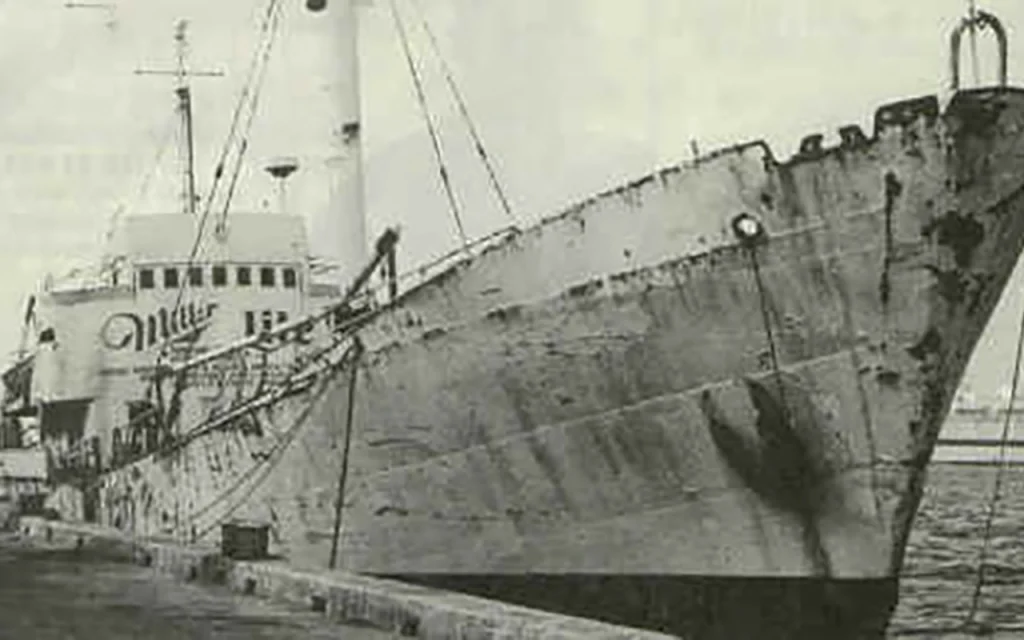
What Historical Features Can Still Be Identified on the Miller Lite Wreck
Structural Elements
- The ship sits upright in 165 feet of water, with its deck at approximately 145 feet depth.
- The overall structure is largely intact, preserving much of its original form.
- The engine room remains large and easily navigable.
Specific Features
- The mast is still erect, often with a solitary barracuda swimming around its top.
- The ship’s boilers are still recognizable and serve as habitat for marine life.
Deterioration
- The front bulkheads of the wheelhouse have collapsed, while the rest of the Miller Lite remains intact.
Artificial Reef Development
- The wreck is now covered in gorgonian growth, indicating its successful transformation into an artificial reef.
- Sea fans and buttercup corals cover much of the wreck’s structure.
Historical Context
- The ship’s overall shape and size (206 feet long) are still apparent, reflecting its origins as a German freighter.
- Its upright position and intact structure allow divers to visualize its original form as a cargo vessel.
What Safety Measures Are in Place for Divers Visiting the Miller Lite
Depth Considerations
- The wreck sits at about 160 feet deep, with the deck at 140-145 feet, requiring advanced diving skills and proper training.
- Wreck Diver Certification is highly recommended for diving on artificial reefs like the Miller Lite.
Dive Planning
- Pre-dive planning and adhering to the plan is crucial due to the depth and potential hazards.
- Divers are advised to stay within their capabilities and not exceed their training limits.
Buddy System
- The buddy system is emphasized as crucial for wreck diving safety.
Equipment
- Divers are advised to carry a knife and/or wire cutter to avoid entanglement in fishing lines or other debris.
Penetration Warnings
- Penetration of the wreck is not recommended due to potential hazards.
Surface Support
- It’s advised to always leave someone aboard the boat who can operate it in case of an emergency.
- Surface support should maintain a watch for divers surfacing downstream of the artificial reef.
Environmental Awareness
- Divers are cautioned to be aware of hazards such as monofilament fishing line and other snags.
- Assessment of ocean conditions (visibility, current, sea state) before and at the dive site is emphasized.
Decompression Procedures
- Proper decompression procedures are essential due to the depth of the wreck.
- Gas switching at appropriate depths (e.g., 70 feet) is part of the safety protocol for technical dives.
Conservation Practices
- Divers are encouraged to practice conservation and courtesy to preserve the reef for future visitors.
Dive Shops That Provide Diving Trips to This Shipwreck
- DH Scuba
- Address: 840 SE 22nd Ave, Pompano Beach, FL 33062
- Phone: (954) 294-5600
- AquaLife Divers Inc.
- Address: 2705 N Riverside Dr, Pompano Beach, FL 33062
- Phone: (954) 231-3483
- South Florida Diving Headquarters
- Address: 101 N Riverside Dr # 111, Pompano Beach, FL 33062
- Phone: (954) 783-2299
Central Florida Wrecks
- SS Breconshire
- Georges Valentine
- Hog Heaven
- Urca De Lima
- USS Rankin
- Ana Cecilia
- United Caribbean
- USS Mindanao
- The Laertes
- Berry Patch Tug Wreck
- The Liberty Ship
- The Ana Cecilia
- The Cities Service Empire
- USS Accokeek
- The Tortuga Wreck
- Princess Ann Wreck (Palm Beach)
- Okinawa Wreck (Pompano Beach)
- MG-111 Wreck (Jupiter)
- Lady Luck Wreck (Pompano Beach)
- Rodeo 25 Wreck (Pompano Beach)
- Lowrance Wreck (Pompano Beach)
- RSB-1 Wreck (Deerfield Beach)
- Rebel Wreck (Deerfield Beach)
- Noulla Express Wreck (Fort Lauderdale)
- Sucre Wreck (Fort Lauderdale)
- Captain Tony Wreck (Pompano Beach)
- Peter McAllister Wreck (Pompano Beach)
- Guy Harvey Wreck (Fort Lauderdale)
- Quallman Tugs Wreck (Pompano Beach)
- Miller Lite Wreck (Pompano Beach)

